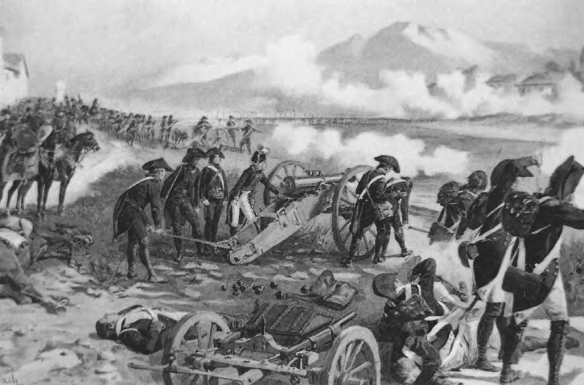
The French victory at Borghetto permitted Bonaparte to cross the Mincio River, take Verona, and put Mantua under siege. The retreat of Feldzeugmeister Jean-Pierre Freiherr Beaulieu’s Austrian army back to Tyrol ended the second phase of the 1796 campaign in Italy.
After the Battle of Lodi and the loss of Milan, Beaulieu had withdrawn behind the Mincio and deployed his army on a line stretching 11 miles from Peschiera to the north and Mantua to the south. The steep riverbanks and the fortresses at either end made it a strong defensive position, with only four bridges (at Peschiera, Borghetto, Goito, and Rivalta) and few fords available for crossing. A serious problem for Beaulieu was that his preferred line of retreat to Tyrol along the upper Adige valley was not perpendicular to the Mincio line but instead ran to the north as an extension of his right wing. To avoid being outflanked on his right side, the Austrian commander deployed his main body between Peschiera and Valeggio. Around Peschiera, Generalmajor Anton Freiherr Liptay commanded the right wing (3,800 men). In the center, Feldmarschalleutnant Michael Freiherr von Melas and Feldmarschalleutnant Karl Philipp Freiherr Sebottendorf had their troops (10,200) scattered along the Mincio between Valeggio and Salionze, with outposts on the right bank. To the south, separated from the rest of the army, Feldmarschalleutnant Michelangelo Alessandro Freiherr Colli-Marchini held Goito with 3,000 men. Several squadrons of good Neapolitan cavalry were attached to Beaulieu’s army.
Being aware of Beaulieu’s concern for his line of communication, at the end of May Bonaparte ordered some feints toward Peschiera and along the western shore of Lake Garda. He then selected General Charles Kilmaine’s 6,200 elite troops to cross over the bridge at Borghetto, deployed Masséna’s division (9,500) behind Kilmaine, and Augereau’s division (6,100) to the left, with orders to threaten Peschiera. To the right, Sérurier’s division (9,100) was to advance as far as Guidizzolo. On the early morning of 30 May, after a rapid march from Castiglione under the cover of the hills overlooking the Mincio, Kilmaine pushed the Austrian outposts back across the river, debouching at around 7:00 A. M. before the western end of the bridge. Owing partly to an indisposition of Beaulieu, the Austrian deployment was far from ideal. As a matter of fact, the crucial bridge was defended by only one battalion (Infantry Regiment Strassoldo) with two guns. Nonetheless, the Austrians resisted for a couple of hours until General Gaspard Gardanne’s grenadiers found a weakly guarded ford farther downstream and managed to reach the left bank. The defenders then abandoned Borghetto and the bridge, retreating to Valeggio. The French pursued and street fighting ensued.
By noon the French were in control of both banks. Despite his attempts, Colli failed to give Beaulieu any support. Meanwhile, Augereau was pushing toward Paschiera. A few successful Neapolitan cavalry charges and limited counterattacks of the infantry reserve at Oliosi gained time for Beaulieu to rally his army and begin the retreat to the north, via Castelnuovo. According to a late (and unconfirmed) French account, in the aftermath of the battle Bonaparte narrowly escaped capture in Valeggio. It is true, however, that after this engagement he established a headquarters escort, which was later to become the Chasseurs a Cheval of the Imperial Guard.
References and further reading Boycott-Brown, Martin. 2001. The Road to Rivoli: Napoleon’s First Campaign. London: Cassell. Ilari, Virgilio, Piero Crociani, and Ciro Paoletti. 2001. Storia militare dell’Italia giacobina, 1796-1802 [A Military History of Jacobin Italy, 1796-1802].Vol. 1, La guerra continentale [The Continental War]. Rome: Stato Maggiore dell’Esercito- Ufficio Storico.